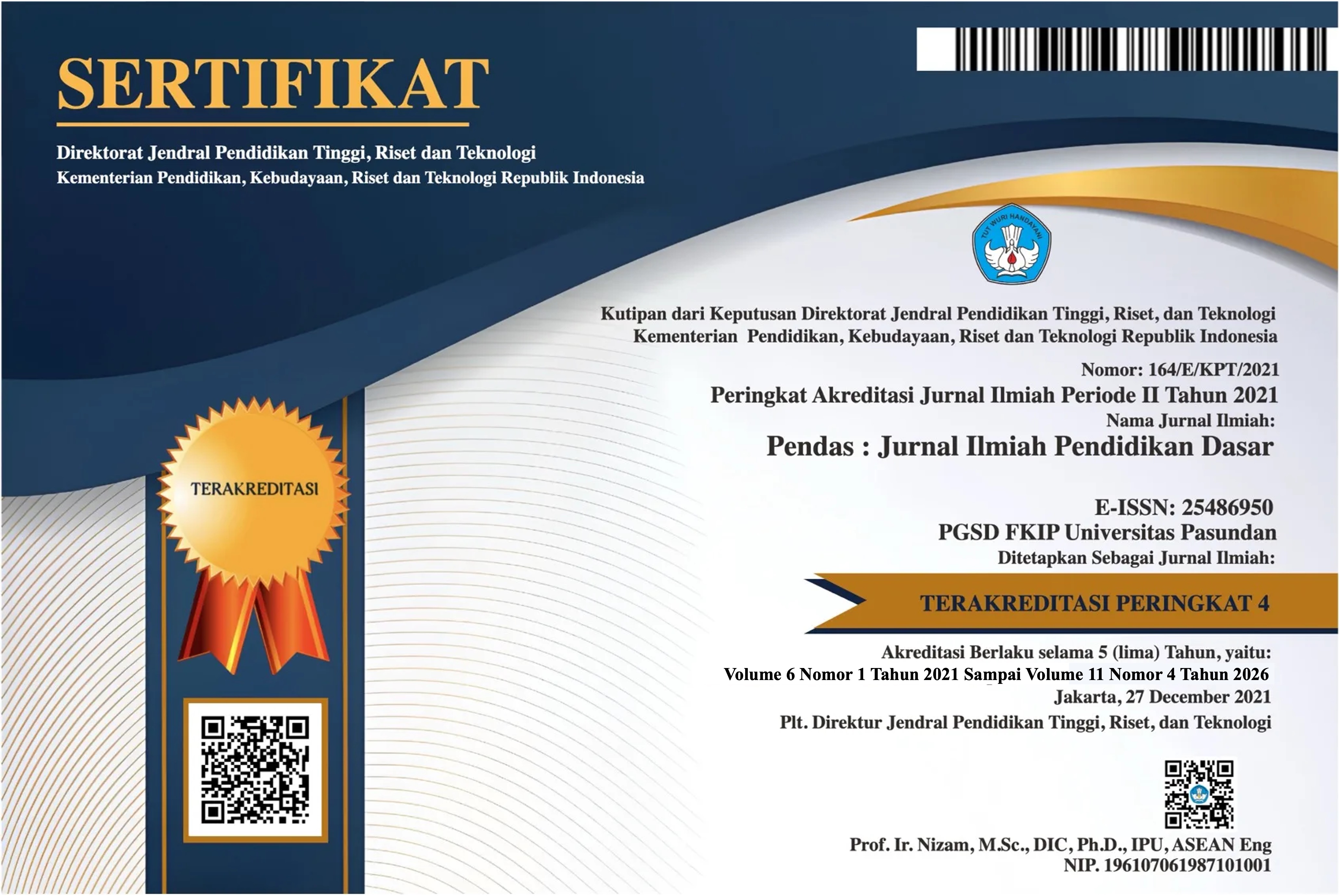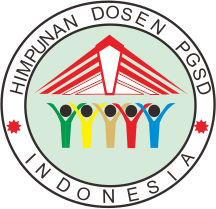EAR LEARNING MODEL: INOVASI PENDIDIKAN RESILIENSI BANJIR BERBASIS ADAPTASI SOSIAL DI SD PEMBANGUNAN LABORATORIUM UNP
DOI:
https://doi.org/10.23969/jp.v10i04.34412Keywords:
EAR Learning Model, Flood Resilience, Social AdaptationAbstract
This study aims to: 1) determine how flood resilience learning is implemented using the EAR Learning Model at SD Pembangunan Laboratorium UNP, 2) determine the effect of implementing the EAR Learning Model on improving students' understanding of flood resilience based on social adaptation at SD Pembangunan Laboratorium UNP, 3) determine how students apply social adaptation in flood-prone environments at SD Pembangunan Laboratorium UNP. This study used a quasi-experimental method with quantitative research and purposive sampling techniques, designating class V.B as the experimental class and class V.A as the control class. The data collection techniques used were observation, tests, documentation, and questionnaires. Flood resilience tests and questionnaires based on social adaptation were given to both classes after the treatment. The tests were given in the form of multiple-choice questions that had been tested for validity, reliability, and observation. The results showed that the implementation of flood resilience learning based on social adaptation used the EAR Learning Model with three syntaxes (Education, Adaptation, and Resilience). The post-test results of the experimental class students who used the EAR Learning Model were higher than those of the control class who used conventional methods. The average score of the experimental class was 77 and that of the control class was 63. Based on the results of the independent sample t-test, it is also known that the significance value is 0.000, which is smaller than 0.05, so H0 is rejected and Ha is accepted, and it can be concluded that the use of the EAR Learning Model has a positive effect on student learning outcomes on flood resilience material based on social adaptation. Based on the social adaptation questionnaire distributed to students in flood-prone areas, it was found that students at the UNP Laboratory Development Elementary School have a high level of social adaptation knowledge.
Downloads
References
Afrian, R. (2021). Kajian Mitigasi Terhadap Penyebab Bencana Banjir di Desa Sidodadi Kota Langsa. Jurnal Georafflesia: Artikel Ilmiah Pendidikan Geografi, 5(2), 165. https://doi.org/10.32663/georaf.v5i2.1660
Andriani, S., & Jatiningsih, O. (2015). Strategi Adaptasi Sosial Siswa Papua Di Kota Lamongan. Kajian Moral Dan Kewarganegaraan, 02(03), 530–544.
Ardianti, R., Sujarwanto, E., & Surahman, E. (2022). Problem-based Learning: Apa dan Bagaimana. Diffraction, 3(1), 27–35. https://doi.org/10.37058/diffraction.v3i1.4416
Aristya Sayu, J., Yusuf Ibrahim, M., & Budjang, G. (n.d.). Adaptasi Sosial Siswa Kelas X Pada Boarding School Sma Taruna Bumi Khatulistiwa.
Balen, D., & Balen, D. (2017). DI SD PILANGGEDE KECAMATAN BALEN KABUPATEN BOJONEGORO Fatiya Rosyida 1 dan Khofifatu Rohmah Adi 2 Abstrak Astract. Jurnal Teori Dan Praksis Pembelajaran IPS, 2(1), 1–5.
Darmawan, Y., Mashuri, I., Jumansa, M., Aslam, F., & Azzahra, A. (2023). Analisis Daerah Rawan Banjir dengan Metode Composite Mapping Analysis (CMA) di Kota Padang (Flood Vulnerability Analysis using Composite Mapping Analysis (CMA) in Padang City). Jurnal Ilmiah Geomatika, 29(December), 89–97.
Gunarta, M. E. (2015). 229330475. 4(02).
Hakim, L., Setiawati, B., & Hawing, H. (2023). Resiliensi Masyarakat dan Penyuluhan Pasca Banjir di Kecamatan Masamba Kabupaten Luwu Utara. Jurnal Penyuluhan, 19(02), 25–36. https://doi.org/10.25015/19202346001
Janah, S. N., & Rohmatun. (2018). Relationship between social support and resilience among tidal wave survivors in tambak lorok. Proyeksi, 13(1), 1–12.
Jarmita, N., Abidin, Z., & Nafizaturrahmi, N. (2019). Penerapan Pendekatan Realistic Mathematics Education Untuk Meningkatkan Pemahaman Konsep Matematika Siswa Sd. Primary : Jurnal Keilmuan Dan Kependidikan Dasar, 11(2), 93. https://doi.org/10.32678/primary.v11i02.2298
Joyce, B., & Weil, M. (1972). Conceptual Complexity, Teaching Style and Models of Teaching. Internasional, 1(1), 1–25.
Khoerunnisa, P., & Aqwal, S. M. (2020). Analisis Model-model pembelajaran. Fondatia, 4(1), 1-27. Jurnal Pendidikan Dasar, 4(1), 1–27.
Mir’atannisa, I. M., Rusmana, N., & Budiman, N. (2019). Kemampuan adaptif melalui resiliensi. Journal of Innovative Counseling, 3(2), 70–75.
Moko, V. T. H., Chamdani, M., & Salimi, M. (2022). Penerapan model Discovery Learning untuk meningkatkan hasil belajar matematika. Inovasi Kurikulum, 19(2), 131–142. https://doi.org/10.17509/jik.v19i2.44974
Nozomi, I. (2023). Penerapan Data Mining Untuk Peringatan Dini Banjir Menggunakan Metode Klastering K-Means (Studi Kasus Kota Padang). Jurnal Sains Informatika Terapan, 2(2), 39–44. https://doi.org/10.62357/jsit.v2i2.165
Nurhidayah, I. J., Wibowo, F. C., & Astra, I. M. (2021). Project Based Learning (PjBL) learning model in science learning: Literature review. Journal of Physics: Conference Series, 2019(1). https://doi.org/10.1088/1742-6596/2019/1/012043
Owen, C. (2019). Problem-Based Learning. Learning and Teaching in Higher Education: Perspectives from a Business School, 139–151. https://doi.org/10.4337/9781788975087.00027
Pokhrel, S. (2024). No TitleΕΛΕΝΗ. In Αγαη (Vol. 15, Issue 1).
Prihatin, R. B. (2018). Masyarakat Sadar Bencana: Pembelajaran dari Karo, Banjarnegara, dan Jepang. Aspirasi: Jurnal Masalah-Masalah Sosial, 9(2), 221–239. https://doi.org/10.46807/aspirasi.v9i2.1106
Rahmat, H. K., Haris Achadi, A., Akbar, A. A., Said, A., Basri, H., Yurika, R. E., Luhur, U. B., & Pencarian Dan Pertolongan, B. N. (2024). Pembelajaran Mitigasi Bencana Berbasis Kearifan Lokal: Sebuah Inovasi dalam Membangun Resiliensi Sekolah. Prosiding Konseling Kearifan Nusantara (KKN), 3, 444–453. https://proceeding.unpkediri.ac.id/index.php/kkn/article/view/4469
Rahmi, & Ernawati. (2024). Adaptasi Peningkatan Resiliensi Ekonomi Masyarakat Terhadap Bencana Banjir Di Kecamatan Padang Utara. Jurnal Pendidikan Tambusai, 8(2), 28007–28016. https://jptam.org/index.php/jptam/article/view/18192
Rusdiana, H. . (2014). Konsep inovasi pendidikan. Pustaka Setia, 187. https://etheses.uinsgd.ac.id/8787/1/Buku Konsep Inovasi Pendidikan.pdf
Serdyukov, P. (2017). Innovation in education: what works, what doesn’t, and what to do about it? Journal of Research in Innovative Teaching and Learning, 10(1), 4–33. https://doi.org/10.1108/JRIT-10-2016-0007
Setiawan, I. N., Krismawati, D., Pramana, S., & Tanur, E. (2022). Klasterisasi Wilayah Rentan Bencana Alam Berupa Gerakan Tanah Dan Gempa Bumi Di Indonesia. Seminar Nasional Official Statistics, 2022(1), 669–676. https://doi.org/10.34123/semnasoffstat.v2022i1.1538
Solissa, E. M., Zuana, M. M. M., Mayasari, N., Haddar, G. Al, & Wariunsora, M. (2022). Analisis Hubungan Resiliensi dan Kecerdasan Emosional pada Siswa Sekolah Menengah Kejuruan. Jurnal Kewarganegaraan, 6(4), 7176–7183. http://journal.upy.ac.id/index.php/pkn/article/view/4440
Sugiarti, S. (2019). Peningkatan Keterampilan Menulis Aksara Jawa Melalui Metode Struktural Tipe Make a Match Pada Siswa Sekolah Menengah Pertama. Edudikara: Jurnal Pendidikan Dan Pembelajaran, 4(3), 192–207. https://doi.org/10.32585/edudikara.v4i3.160
Sulaiman, M. E., Setiawan, H., Jalil, M., Purwadi, F., S, C. A., Brata, A. W., & Jufda, A. S. (2020). Analisis Penyebab Banjir di Kota Samarinda. Jurnal Geografi Gea, 20(1), 39–43. https://doi.org/10.17509/gea.v20i1.22021
Svinicki, M. D. (1998). A theoretical foundation for discovery learning. The American Journal of Physiology, 275(6 Pt 2), 4–7. https://doi.org/10.1152/advances.1998.275.6.s4
Try, N., Fitria, Manalu, F., Rustini, T., & Wahyuningsih, Y. (2022). Pembelajaran Mitigasi Bencana Banjir Terhadap Siswa Sekolah Dasar. Didaktik : Jurnal Ilmiah PGSD STKIP Subang, 8(1), 290–302. https://doi.org/10.36989/didaktik.v8i1.270
Downloads
Published
Issue
Section
License
Copyright (c) 2025 Pendas : Jurnal Ilmiah Pendidikan Dasar

This work is licensed under a Creative Commons Attribution 4.0 International License.


















